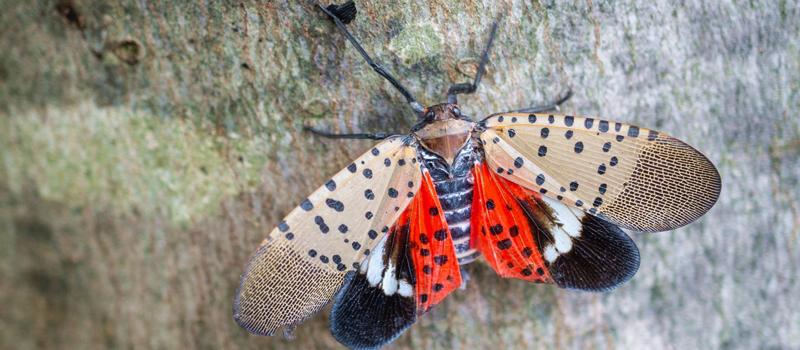Breeding Lanternflies Found in Fitchburg MA
Posted by Mosquito Squad
December 20, 2023
Do not let their striking spots and coloring fool you, spotted lanternflies are enemy invaders in Massachusetts.
This past Tuesday, agricultural inspectors discovered an infestation of lanternflies in Fitchburg. While the infestation is said to be exclusive to one small cluster of trees, further surveys are being carried out. For a few years now, single lanternflies have been reported throughout the state. This infestation is the first on record in the state of Massachusetts.
Why are lanternflies bad?
These spotted-winged insects feed on shrubs, grapevines, fruit trees, and other wood species. Using a proboscis, just like the mosquito, lanternflies feed on sap. They typically do not directly kill the trees and plants they feed on, but they do make them fragile and susceptible to other types of infestations – be they bugs, worms, or fungi. Lanternflies also leave behind a black mold sort of substance that will eliminate grout cover plants that surround their host trees.
Where do lanternflies come from?
Lanternflies were first found in the United States back in 2014. They are suspected to have arrived on a shipment of stone building materials, which originated in Asia. Some sources say the shipment came in from Korea; others say China.
How might lanternflies become pervasive in Massachusetts?
Though they can be found in 11 states on the east coast, lanternflies are not yet considered a pervasive insect in the United States. Infestations cover a small area at a time and spread slowly, because the adult lanternfly simply jumps from one tree or plant to another, using its wings to glide, rather than fly. However, female lanternflies will adhere their eggs to the sides of buildings, on lawn furniture, or even on cars, offering new clusters to grow and reproduce in areas outside of the current infestation. Add to that, one of their favorite host trees is a pervasive plant in the United States. For more than a millennium the lanternfly and the tree of haven have harmoniously co-existed in Asia. In the late 1700’s, the tree of haven was brought to the United States, likely due its beauty. The tree quickly became an invasive plant species, growing up to three feet, and producing more than 300,000 seeds per year. What’s worse, the tree of haven kills surrounding plant life by emitting a natural herbicide into surrounding soil. The flowers, though beautiful, also produce an offensive odor. There is not a lot to love about the tree of haven, but the lanternfly feels right at home there. So, areas with much of this invasive tree could become home to lanternfly populations too!
Will mosquito control kill lanternflies?
Mosquito control barrier protection will work to eliminate lanternflies around your home. Some areas of the country are having aerial sprays performed to control the spread of this dangerous insect, but as we are all aware, municipal sprays are never equivalent to having your property protected with Mosquito Squad’s barrier mosquito protection.
If you find a lanternfly on your property, snap a photo, document the location it was found, and kill it. It is also recommended that any Mass resident, who locates a lanternfly anywhere in the state, to report it to the Massachusetts Department of Agricultural Resources. For at-home mosquito control and tick protection, call Mosquito Squad of Leominster today at (978) 321-2670.
